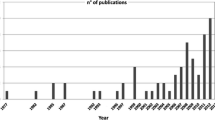Abstract
Naturally occurring isotopes of elements like strontium have proved to be good tools for tracing the past and for monitoring of processes in the present. The spread and variation in87Sr/86Sr ratios make Sr isotopes a powerful tool when it comes to detecting trends in the soil-vegetation system. There is also a great potential in combining different parameters like soil, water, biological material and isotopes for detecting environmental changes over short as well as long time periods. Sampling of the past is a difficult task but biological material, in combination with inorganic material, proves advantageous as environmental archives. There is also the possibility of using museum collections as environmental historic archives. This paper discusses the potential of using the natural87Sr/86Sr ratio as a tracer for environmental studies. The results presented point to an ongoing impoverishment of the environment and show that the temporal trend in Sr isotope composition for different media is similar despite material and location of test area.
Similar content being viewed by others
References
åberg, G. and Jacks, G.: 1985, ‘Estimation of Weathering Rate by87Sr/86Sr Ratios’,Geologiska Föreningens i Stockholm Förhandlingar 107, 289–290.
åberg, G. and Jacks, G.: 1987, ‘87Sr/86Sr as a Tool in Studies of Weathering Rates’, in Y. Tardy and R. Rodriguez-Clemente (eds.),Geochemistry and Mineral Formation in the Earth Surface. Cons. Super. Invest. Cient., Barcelona, Spain, pp. 67–76.
åberg, G. and Wickman, F. E.: 1987, ‘Variations of87Sr/86Sr in Water from Streams Discharging into the Bothnian Bay, Baltic Sea’,Nord. Hydrol. 18, 33–42.
åberg, G., Jacks, G. and Hamilton, P. J.: 1989, ‘Weathering Rates and87Sr/86Sr Ratios: An Isotopic Approach’,J. Hydrol. 109, 65–78.
åberg, G., Jacks, G., Wickman, T. and Hamilton, P. J.: 1990, ‘Strontium Isotopes in Trees as an Indicator for Calcium Availability’,Catena 17, 1–11.
Andersson, P., Löfvendahl, R. and åberg, G.: 1990, ‘Major Element Chemistry,2H,18O and87Sr/86Sr in a Snow Profile Across Central Scandinavia’,Atmos. Environ. 24A, 2601–2608.
Biscaye, P. E., Chesselet, R. and Prospero, J. M.: 1974, ‘Rb/Sr,87Sr/86Sr Isotope System as an Index of Provenance of Continental Dusts in Open Atlantic Ocean’,J. Rech. Atmosph. 8, 819–829.
Blum, J. D., Yigal, E. and Brown, K.: 1993, ‘87Sr/86Sr Ratios of Sierra Nevada Stream Waters: Implications for Relative Mineral Weathering Rates’,Geochim. Cosmochim. Acta 58, 5019–5025.
Carell, B., Forberg, S., Grundelius, E., Henrikson, L., Johnels, A., Lindh, U., Mutvei, H., Olsson, M., SvÄrdström, K. and Westermark, T.: 1987, ‘Can Mussel Shells Reveal Environmental History?’,Ambio 16, 2–10.
Falkengren-Grerup, U. and Tyler, G.: 1992, ‘Changes Since 1950 of Mineral Pools in the Upper C-horizon of Swedish Deciduous Forest Soils’,Water, Air, and Soil Pollut. 64, 495–501.
Faure, G.: 1986,Principles of Isotope Geology, 2nd edition. John Wiley &; Sons. New York.
Gosz, J. R., Brookins, D. G. and Moore, D. I.: 1983, ‘Using Strontium Isotope Ratios to Estimate Inputs to Ecosystems’,BioScience 33, 23–30.
Graustein, W. C. and Armstrong, R. L.: 1983, ‘The Use of Strontium-87/Strontium-86 Ratios to Measure Atmosphere Transport into Forested Watersheds’,Science 219, 289–292.
Jacks, G., åberg, G. and Hamilton, P. J.: 1989, ‘Calcium Budgets for Catchments as Interpreted by Strontium Isotopes’,Nord. Hydrol. 20, 85–96.
Löfvendahl, R., åberg, G. and Hamilton, P. J.: 1990, ‘Sr in Rivers of the Baltic Basin’,Aquat. Sci. 52, 315–329.
Miller, E. K., Blum, J. D. and Friedland, A. J.: 1993, ‘Determination of Soil Exchangeable-cation Loss and Weathering Rates Using Sr Isotopes’,Nature 362, 438–441.
Schmitz, B., åberg, G., Werdelin, L., Forey, P. and Bendix-Almgreen, S-E: 1991, ‘87Sr/86Sr, Na, F, Sr, and La in Skeletal Fish Debris as a Measure of the Paleosalinity of Fossil Fish Habitats’,Geol. Soc. Am. Bull. 103, 786–794.
Wadleigh, M. A., Veizer, J. and Brooks, C.: 1985, ‘Strontium and its Isotopes in Canadian Rivers: Fluxes and Global Implications’,Geochim. Cosmochim. Acta 49, 1727–1736.
Wickman, F. E., and åberg, G.: 1987, ‘Variations in the87Sr/86Sr Ratio in Lake Waters from Central Sweden’,Nord. Hydrol. 18, 21–32.
Author information
Authors and Affiliations
Rights and permissions
About this article
Cite this article
åberg, G. The use of natural strontium isotopes as tracers in environmental studies. Water Air Soil Pollut 79, 309–322 (1995). https://doi.org/10.1007/BF01100444
Received:
Accepted:
Issue Date:
DOI: https://doi.org/10.1007/BF01100444




